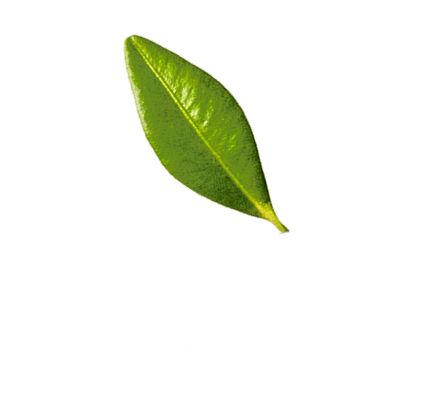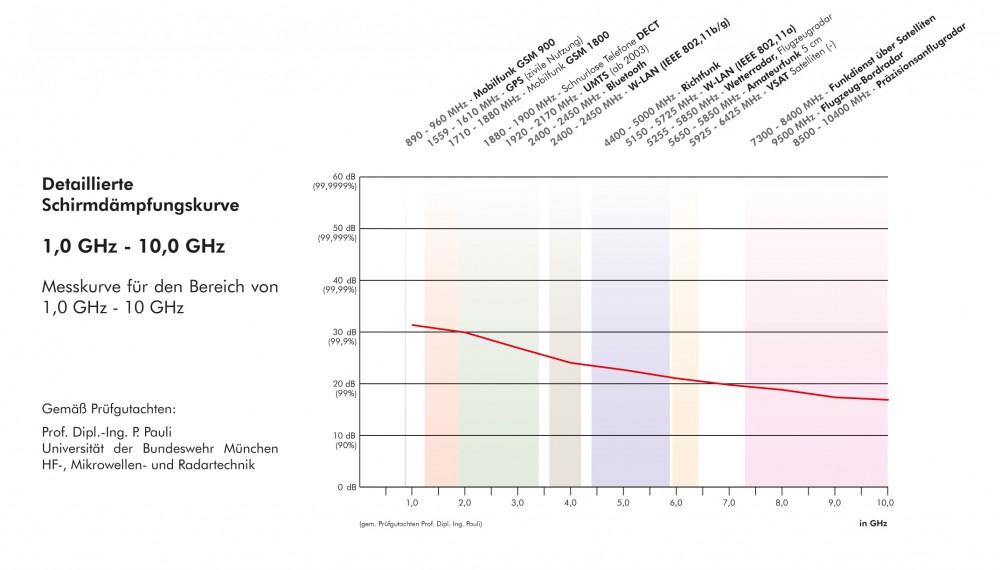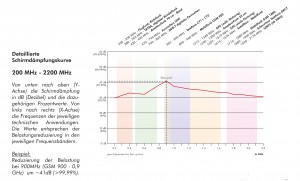Fabrics
General
Electrosmog shielding fabrics
There are a variety of shielding substances for protection against electrosmog. We can divide them into the following categories:
- Shielding fabrics
- Shielding knitted fabrics
- Shielding knits
Shielding fabrics act as technical textiles in the field of electromagnetic radiation shielding. Due to their light weight, the fabrics are used as EMC shielding materials in various technical products.
Thanks to the antimicrobial effect of silver, the shielding knitted fabrics and shielding knits can be used e.g. for skin diseases.
In addition to their shielding properties, each of these shielding fabrics has various other properties such as breathable, abrasion-resistant, flame-retardant, electrically conductive and antibacterial.
The degree of shielding and these properties determine their use.
Electromagnetic shielding fabrics for clothing:
- Underwear,
- Pajamas,
- accessories and
- clothing for men and women.
- Underwear,
- Pajamas,
- accessories and
- clothing for men and women.
Shielded fabrics for home use:
- Shielding curtains,
- shielding canopies,
- shielding bed linen.
Shielded fabrics for industrial applications:
- Industrial tents
- Architectural room shielding
- Industrial tents
- Architectural room shielding
Digital & Mobile Forensics
These shielding fabrics can be made of natural or synthetic yarns (mainly polyester) and contain a metal alloy core that can isolate electromagnetic fields.
Polyamide is the basic material of our silver fabrics. It gives the textiles strength and elasticity. The 99.9% pure silver differs from other metals as a light and flexible precious metal, an electrical and thermal conductor, and its antimicrobial and excellent shielding properties.
Shielding fabrics with silver and copper are used in the manufacture of clothing, canopies and curtains.
Silver and polyamide make a perfect team
Polyamide gives textiles their strength and elasticity. 99.9% pure silver is a light, pliable precious metal that is an excellent electrical and thermal conductor and therefore also has high EMC properties.
Copper
Like silver, copper is also an electrical and thermal conductor. Its special performance lies in the area of EMC shielding.
In industrial applications, the shielding materials used also contain nickel and tin.
Tin
Tin is the master of metals. Tin coating enables soldering of the fabrics while guaranteeing flexibility and extremely high conductivity of the textile.
Nickel
Nickel increases conductivity and also serves as corrosion protection for silver and copper coatings.
Depending on the metal content and material properties, these products are ideal for EMC Shielding.
To ensure effective shielding against high and also low frequency electromagnetic radiation, we offer various fabrics for clothing, curtains and canopies.




Fabrics for clothing:
Poplin 150
- for shielding of high frequency electromagnetic waves
- excellent shielding effect
- good washability
- for shielding of high frequency electromagnetic waves
- excellent shielding effect
- good washability
Description
Finest copper threads are coated with silver for optimum compatibility. To exclude electrical conductivity and prevent oxidation, the metal thread is then coated with polyester. The whole is covered with cotton and the resulting yarn is finally twisted with a second, pure cotton yarn. In contrast to twill, a thinner cotton yarn is used here.
Due to the shielding effect of a very fine metal grid in the fabric, electromagnetic radiation is prevented from penetrating. Depending on the frequency, the shielding is between 98 and 99 percent.
Poplin is a fabric with a fine, tight ribbing; it is absorbent, soft and slightly silky. To make poplin, weavers use a warp thread that is finer than the weft thread.
The particularly dense fabric is very durable and low iron. Due to the uniform metallization, preferred levels with different screen attenuations are not present.
Technical data:
Width: | 1,50 m |
Composition: | full twist poplin 97 % cotton, 3 % metal (silver plated fine copper thread) |
Color: | white, light blue, royal blue, cream |
Properties: | washable, colorfast |
Care Instructions: | The fabric can be washed at 30°C in gentle cycle. However, the fabric should not be spun or machine dried, as this could cause thread breakage. With the recommended treatment, no reduction in the shielding effect can be detected even after 30 washes. |
Basis for testing: | IEEE 299-1997 ASTM D 4935-89 |
Shielding effectiveness: | 45-18 dB at 200 MHz to 2,4 GHz Corresponding to approx. 99,995% – 98% |




Köper 150
- for shielding of high frequency electromagnetic waves
- excellent shielding effect
- good washability
- for shielding of high frequency electromagnetic waves
- excellent shielding effect
- good washability
Description
Finest copper threads are coated with silver for optimum compatibility. To exclude electrical conductivity and prevent oxidation, the metal thread is then coated with polyester. The whole is covered with cotton and the resulting yarn is finally twisted with a second, pure cotton yarn.
The shielding effect of a very fine metal grid in the fabric prevents electromagnetic radiation from penetrating. Depending on the frequency, shielding is between 98 and 99 percent.
The twill weave is one of the three basic weave types for woven fabrics. A weave characterized by the presence of diagonal ribs on the front side and smooth on the back.
The particularly dense fabric is very durable and low iron. Due to the uniform metallization, preferred levels with different shielding attenuations are not present.
Technical data:
Width: | 1,50 m |
Composition: | Twill weave 97% cotton, 3% metal (silver plated fine copper thread) |
Color: | white, lightblue, pink, light grey, beige |
Properties: | washable, colorfast |
Care Instructions: | The material can be washed at 30°C on the gentle cycle. However, the fabric must not be spun or machine dried, as this could cause thread breakage. With the recommended treatment, no reduction in the shielding effect can be detected even after 30 washes. |
Basis for testing: | IEEE 299-1997 ASTM D 4935-89 |
Shielding effectiveness: | 45-18 dB at 200 MHz to 2,4 GHz Corresponding to approx. 99,995% – 98% |




Shielding-cotton-silver
- for shielding of high frequency electromagnetic waves
- excellent shielding effect
- good washability
- 100 % textile properties
- skin-friendly, wash-resistant and free of nanotechnology.
- for shielding of high frequency electromagnetic waves
- excellent shielding effect
- good washability
- 100 % textile properties
- skin-friendly, wash-resistant and free of nanotechnology.
Description
This quality is a right-left jacquard knit, in a combination of combed cotton and polyamide coated with silver. The coating is not controversial nano-silver, but 20% pure silver surrounding the entire polyamide fiber. The metallic silver is absolutely harmless to human health and to nature.
Due to the innovative structure of the fabric and the use of high-quality materials, this knitted fabric protects against electromagnetic radiation in the range of 20 kHz to 10 GHz, with an efficiency of up to 99%. This is confirmed by an expert opinion of Prof. Pauli from the University of the Federal Armed Forces in Munich.
Technical data:
Width: | 175 cm ± 2% |
Composition: | 89% cotton, 9% polyamid, 2% silver |
Color: | white / silver |
Weight per unit area: | 140 g/m² ±10% |
Thickness: | 0,5 mm ± 10% |
Mesh size: | < 0,1mm x 0,1mm |
Basis for testing: | IEEE 299-2006 |
Shielding effectiveness max. in % : | > 99,0 % |
Shielding effectiveness max. in dB : | ~ 33 dB |




Fabrics for curtains and canopies
Screening voile Ecologa
- For large area shielding of high frequency electromagnetic waves
- Fully metallized
- excellent shielding effect
- Transparent, easy to make up
- For large area shielding of high frequency electromagnetic waves
- Fully metallized
- excellent shielding effect
- Transparent, easy to make up
Description
A soft flowing, permeable fabric is used as an intermediate fabric in making up clothes as well as a curtain for shielding entire rooms and sleeping areas. We also use Voile Ecologa in the manufacture of our canopies.
The fabric is transparent, airy and pleasant to the touch. Due to the fabric construction with silver-plated copper threads in the warp and weft, the fabric can be washed as many times as needed without losing its special properties.
The screening attenuation of this very open fabric construction is unusually high and independent of direction.
Technical data:
Width: | 300 cm/meter (+– 5 cm) Roll approx. 30 m |
Color: | natural or snow white |
Composition: | Polyester 90%, Metal 10% |
Weight: | 60 g/sqm |
Shielding effectiveness: | 40 – 20dB at 400 MHz to 6 GHz |
Care Instructions: | The material can be washed at 30°C on the gentle cycle. However, the fabric must not be spun or machine dried, as this could cause thread breakage. With the recommended treatment, no reduction in the shielding effect can be detected even after 30 washes. |




Shielding knitted fabric„Silver Tulle 110“
- for large-area shielding of high-frequency electromagnetic waves
- Fine silver coated, fully metallized
- elastic, soft nylon knitted fabric
- excellent shielding effect
- semi-transparent, easy to make up
- for large-area shielding of high-frequency electromagnetic waves
- Fine silver coated, fully metallized
- elastic, soft nylon knitted fabric
- excellent shielding effect
- semi-transparent, easy to make up
Description
A fine silver metallized polyamide knitted fabric with excellent damping properties. The individual fibers are fully silver-plated all around, making the fabric highly electrically conductive and easy to contact. Due to the uniform metallization, distortion levels with different shielding attenuations are not present. Grounding accessories are not included in the scope of delivery.
The knitted fabric is antiseptic, soft and supple, with an absolutely textile character. It is particularly suitable for shielding high-frequency electromagnetic waves and, if suitably grounded, can also be used for shielding low-frequency alternating electric fields.
In the event that grounding is necessary, please observe our “Safety instructions and grounding regulations”. Silver-plated products have the property of changing color due to tarnishing. This usually has no influence on the shielding effectiveness of the material.
Not suitable for outdoor use.
Technical data:
Width/Length: | ca. 110m / yard goods |
Color: | Old silver |
Surface resistance: | < 1.4 Ω/o |
Metallization: | With 10 % silver |
Thickness: | 0.22 mm ± 10 % |
Weight: | 33 g/m² -3/+5 g/m² |
Test standards: | MIL-STD 285, NSA 65-6 |
Composition: | 100 % polyamide / nylon 6.6 |
Shielding effectiveness (0,2–2 GHz) : | < 45 dB from 0.2 GHz – 2 GHz |
Shielding effectiveness (2-5 GHz) : | < 40 dB from 2 GHz – 5 GHz |
Shielding effectiveness (5-14 GHz) : | < 36 dB from 5 GHz – 14 GHz |




Screen curtain fabricLinon
- for large-area shielding of high-frequency electromagnetic waves
- 100% textile properties
- extremely noble
- available in 330 cm ceiling height
- for large-area shielding of high-frequency electromagnetic waves
- 100% textile properties
- extremely noble
- available in 330 cm ceiling height
Description
The soft flowing fabric is used in making up shielding canopies, as well as curtain fabric for shielding entire rooms and sleeping areas.
The fabric is ½-transparent, airy and pleasant to the touch. The fabric is spun in with silver-plated copper threads.
Linon is distinctly noble and adapts to any style.
The shielding effectiveness of this very open fabric construction is unusually high and independent of direction.
Technical data:
Width/Length: | 330cm / yard goods |
Color: | light gray |
Weight: | 0,110 kg/m² |
Test standards: | MIL-STD 285, NSA 65-6 |
Shielding effectiveness: | max. 40 dB |
Learn more about:
Important note
Shielding materials only exhibit an effective shielding effect if you are appropriately grounded.






